#sinai vessel
Explore tagged Tumblr posts
Text
Sinai Vessel - How
0 notes
Text
Also preserved on our archive
The casual ablists are finally connecting dots folks like me connected 4 years ago... (๑ᵕ⌓ᵕ̤)
By Tapatrisha Das
Covid virus can cause myocarditis, which can further push the heart to an attack. Here's why there’s a rise in heart attacks among young adults.
Earlier, heart attacks were thought to be a disease that affected one in later years but not anymore. There has been a disturbing rise in the number of young people suffering from heart attacks. Especially in healthy young adults, this disease has been observed at a more alarming rate. In the last four years, there has been a 66 percent rise in the number of heart attacks in young people in America – with one in every five heart attack patients being under the age of 40. A report on Daily Mail has explored the connection of this trend with the Covid-19 pandemic.
Reasons behind alarming rise of heart attacks in young adults The report mentions that many factors are at play in increasing the risk of heart attacks in young and fit adults – drug use, obesity and sedentary lifestyle are some of the main reasons. However, considering the timing, Covid-19 is also suspected to be at play here.
The Covid-19 virus can cause widespread inflammation throughout the body, especially affecting the heart and causing blood clots. During the lockdown, people were bound to stay at home – this further triggered depression, anxiety and stress. These all can trigger heart attack risk.
Impact of covid: The timing of surge in heart attacks is suspected to be directly related to the covid pandemic. The covid virus, once inside the body, can cause the heart to be inflamed – this condition is known as myocarditis. This further makes it hard for the heart to pump blood throughout the body. This condition can damage the heart and make it incapable to pump blood throughout the body. This is when heart attacks become more common.
The Daily Mail report also quoted Dr Susan Cheng, a cardiologist at Cedars Sinai who authored a 2023 study that found heart attack deaths in people 25 to 44 increased by nearly 30 percent during pandemic's early years. She had said back then as well that the connection was 'more than coincidental.'
'Young people are obviously not really supposed to die of heart attack. They're not really supposed to have heart attacks at all…There are a lot of things that COVID can do to the cardiovascular system. It appears to be able to increase the stickiness of the blood and increase... the likelihood of blood clot formation. 'It seems to stir up inflammation in the blood vessels. It seems to also cause in some people an overwhelming stress—whether it's related directly to the infection or situations around the infection—that can also cause a spike in blood pressure.'
#mask up#covid#pandemic#covid 19#public health#wear a mask#coronavirus#sars cov 2#still coviding#wear a respirator#long covid#covid conscious#covid is airborne
90 notes
·
View notes
Text
In its fortieth year, Israel remains in a state of war with several Arab neighbors. That is bedrock. It must never be forgotten in discussing the Land and the Faith. No guns are going off as I write, in March 1987, but formal hostilities exist with no end in sight. The Jewish populace has grown in forty years from half a million to more than three million. The Israel Defense Force has become a military power without peer for its size; considered comparable, in some aspects of tactics and technology, to superpower forces. That is probably way the guns are not firing at the moment.
Since I wrote "The Ashes and the Gold" in 1969, the remarkable chronicle of the Jewish State has been punctuated by further military exploits The brilliant but scary and very costly turnaround victory in the Yom Kippur War of 1973, the airborne rescue of hostages from Arab terrorists at Entebbe in 1976, the controversial expulsion of the PLO terrorists from Lebanon, the surgical bombing of the nuclear reactor in Iraq, the air strike on the terrorist headquarters in Tunis; such high combat drama has repeatedly made world headlines.
The Israelis would gladly trade all that adventure and glory for peace. They have proved it. I was present at the lowering of the flag at the Sharm El Sheikh naval base in April 1982, a final step in their peaceful evacuation of the Sinai peninsula, under the Camp David agreement. A son of mine was serving in a Wasp patrol boat based there. After the ceremony I sailed with him up the Red Sea to Eilat, the new base for his vessel, having witnessed the most impressive sacrifice for peace made by a nation in modern times. I will never forget the sight of his Wasp squadron, circling around and round full speed offshore with sirens eerily wailing, in the farewell ceremony for a lost ship; nor the ranks of girl soldiers in white dress uniform on the wharf, standing at attention and weeping as the Star of David flag came down. Egypt lost the war to regain Sinai by force of arms. The Israelis gave back this strategic buffer of their own accord, to fulfill their part of a breakthrough peace on one front.I once asked an Israeli general how it was that his tiny new nation had so swiftly acquired remarkable military prowess. He replied, "We had to." That is the long and the short of it. The oil-rich Arabs can buy all the weaponry they require from other countries, mainly the Soviet Union. The Israelis have to build their own tanks, and much of their defense materiel. So they have learned to make armaments, and to excel in advanced technology, scientific and agricultural as well as military, for one and the same reason: they have had to.
- This Is My God, Herman Wouk, page 273-274
#this is my god#herman wouk#jumblr#frumblr#israel#israeli history#history#jewish history#antisemitism
54 notes
·
View notes
Note
pls recommend some music,,, I have to survive a work college day ☹️
Sinai vessel - brokenlegged
Oliver Houston - whatever works
Father John Misty - God's favorite customer
Cloud nothings - here and nowhere else
Telefon tel Aviv - fahrenheit fair enough
The books - the lemon of pink
Narc Twain - s/t ep
Sister cities - swan dive
Weatherbox - flies in all directions
All get out - no bouquet
Tunng - comments of the inner chorus
Hope there's at least one in there you haven't heard
42 notes
·
View notes
Text
The Food and Drug Administration recently approved a heart stent made specifically for infants and young children, a device that could help kids born with certain congenital heart defects avoid a series of open heart operations over their childhoods. About 40,000 babies are born with congenital heart defects in the U.S. each year, according to the Centers for Disease Control and Prevention. In some cases, those defects are treated with stents, which prop open blood vessels, ensuring that blood can properly flow through them. Typically, when infants and young children need stents, surgeons trim or modify adult-size stents and squeeze them into the tiny vessels of infants’ hearts, which are about the size of a walnut. (An adult’s heart is about the size of a fist.) “What we’ve been doing for the past three decades is kind of jerry-rigging these adult stents and making them work for our patients,” said Dr. Evan Zahn, a pediatric cardiologist and director of the Guerin Congenital Heart program at Cedars Sinai Medical Center in Los Angeles. “You can imagine that is less than ideal — they’re too big.” This means that as the child grows older and their blood vessels get bigger, stents have to be replaced, often with open heart surgery, Zahn said. “It’s not unusual to have kids who are going into middle school who’ve had four or five or even six open heart surgeries,” he said. “Their survival is great, but the amount of what I call therapeutic trauma that they have to go through is quite a burden.” The Minima stent, from the California-based biotech company Renata, is designed to grow with the child as he or she ages.
10 notes
·
View notes
Text
Nose rings in Egypt
Wearing nose rings in the Eastern Mediterranean actually goes back to the time that the Torah was being written. Referred to as nezemim, Rebecca is noted as wearing one. The practice continues to this day, though they are less common and have grown to be more strongly associated with South Asia and Alt sub cultures. Today it is thought that the wearing of nose rings in India may have been imported from West Asia (the assertion that they were brought over by the Mughals seems inaccurate, however, as the first mention of them is from around 1000 AD)- the discussion is somewhat contentious and unfortunately often feeds into political violence and bias against Muslims when mentioned.
The earliest modern depuction of a nose ring being worn in Egypt comes from the 1830s, thanks to our old enemy and research dog, Edward William Lane. He describes then as being made of brass or occasionally gold with glass beads attached to them, an inch to an inch and a half in diameter, says they are worn on the right side of the nose. His account associates them with poor women. He records the name as "khizám" or "khuzám".
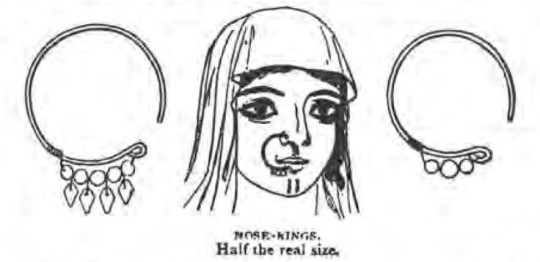
A difficulty comes in recognizing nose ring examples held in museums; I have found a few items resembling this style, but they are described as earrings. The V&A is responsible for two cases, and given they have gotten information wrong on both Ancient and Modern Egyptian jewelry, my suspicion is these examples may be misidentified. The two examples will be shown promptly.

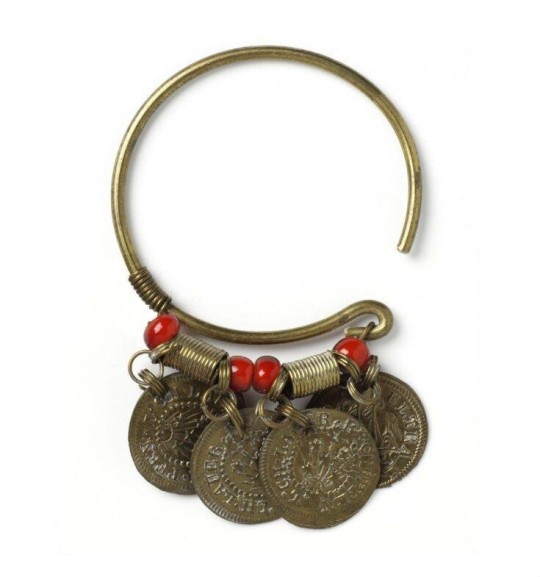
Another example of dubious identification comes from a design that may be multipurpose; silver rings with an openwork barrel at one end. The TRC Leiden institute has an example from Saudi Arabia and claims its a nose ring, but it bears close resemblance to some Egyptian examples identified as earrings, and those resemble some Coptic bronze examples also identified as earrings. To my mind this style also resembles Amazigh earrings/head ornaments (these were sometimes attached to the headdress, not the ears themselves). It is also possible that TRC Leiden has misidentified the item.
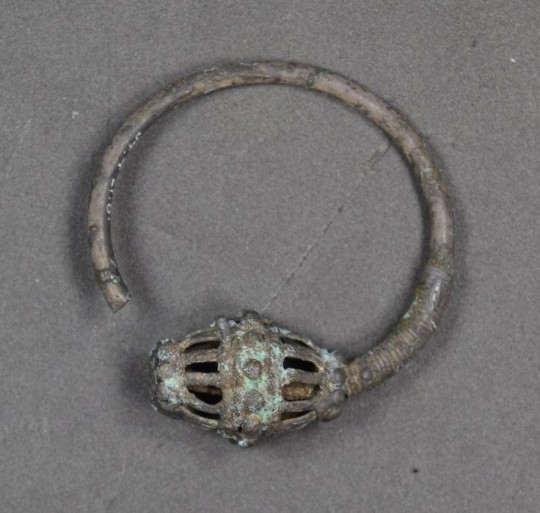
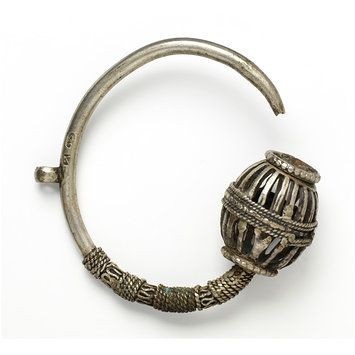

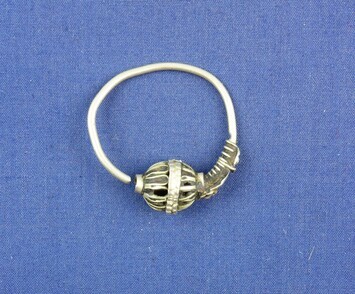
While Lane says nose rings were worn all over Egypt, the modern discussion I've found strongly associates them with Bahariya, where they are called gatar or qatrah. There, they are made of gold (usually 12 carat), with filigree and granulation filling the lower half, worn on the right side by married women. They also typically have a large flat circle of gold covering the gap where the wire goes through the nose. This is either soldered on or apart of the central wire the nose ring is built around. Occasionally a coral or glass bead is threaded into the wire that passes through the nose. They are never made of silver, as local women say silver would damage the blood vessels in the nose. They also feel that the nose ring prevents pain and headaches while worn, and when a piece has to be sent off to repair, they urge the person transporting it to hurry back.

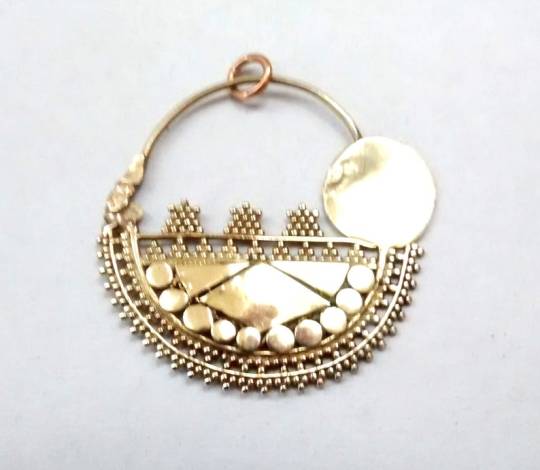


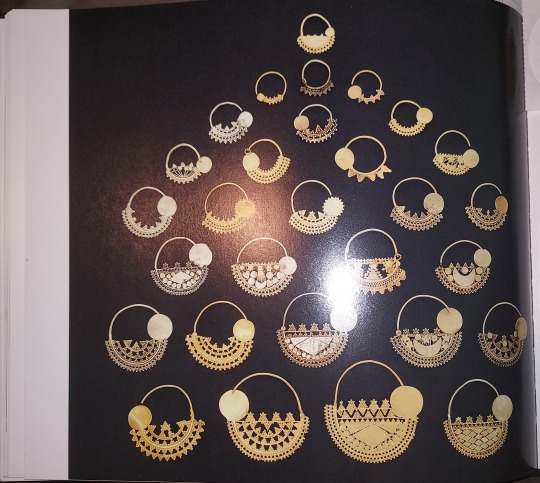
I've found some discussion of nose rings as worn by Nubians, Sinai Bedouins, and Bisharin (Beja), Ababda (who have closely intermarried with the Bisharin), and Rashayda. The name recorded as used by Nubians and Beja is zimam. I haven't seen enough examples of Nubian or Beja Egyptian nose rings to draw conclusions about common manufacture, but I do have a few examples. One piece, attributed to Egypt by the Philadelphia museum, is a sliver ring with part of the wire flattened and cut halfway through. Azza Fahmy also provides a photo, putting it under a collection of earrings from the Red Sea area. Similar nose rings can be seen in these two photos from Sudan. I have also seen a photo allegedly of an Egyptian Nubian girl with a gold nose ring that has a similar partially flattened design.




Other Sudanese nose rings I've seen are gold, with a chain leading from the ring to the hair, in a similar fashion to the nath in India. However, these are not necessarily synonymous with Nubian nose rings, as Sudan has an Arab/Arabized cultural majority. At some point I'd like to ask someone who knows more about the subject if there is a distinction between the two styles, but as of now I do not know anyone who is knowledgeable on the matter, nor do I know of any academic texts that discuss the issue.
Beja jewelry has a strong influence from Nubian and Sudanese styles, owing to the fact that they live in proximity, and that more Beja live in Sudan than Egypt. Like Nubians, the Beja are an Indigenous group. They're believed to be related to the Blemmyes and the original group referred to as Medjay in Ancient Egypt, and some ostracon exist of their languages written in the Coptic alphabet (The Nubian alphabet is related to the Coptic alphabet as well, with unique letters for certain sounds). I have little information on the Rashayda, but they call their nose ring zimam. They claim to be descended from an Arab tribe, and some information I've seen implies they've intermarried with the Beja. Two nose piercings are in use by the Beja and Rashayda; a diamond shaped one worn in the center bulb of the nose, worn by Beja women, and gold nose rings with engraved designs or strung with beads, worn by both. 21k is the preference in Nubian goldwork, and this seems to be true of these groups as well.

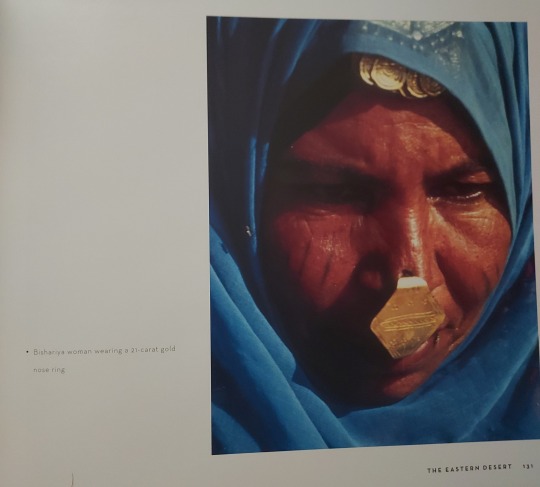

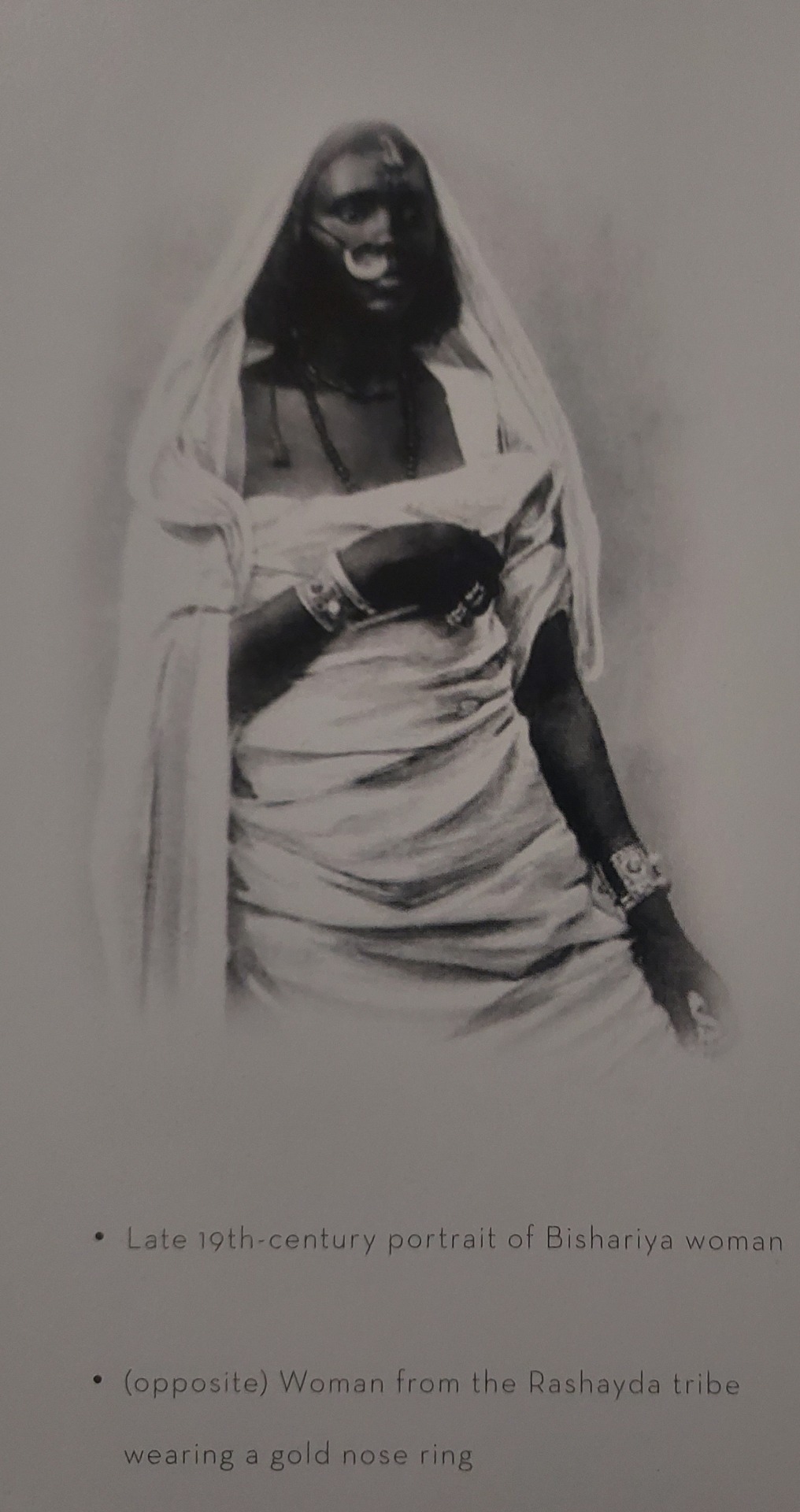
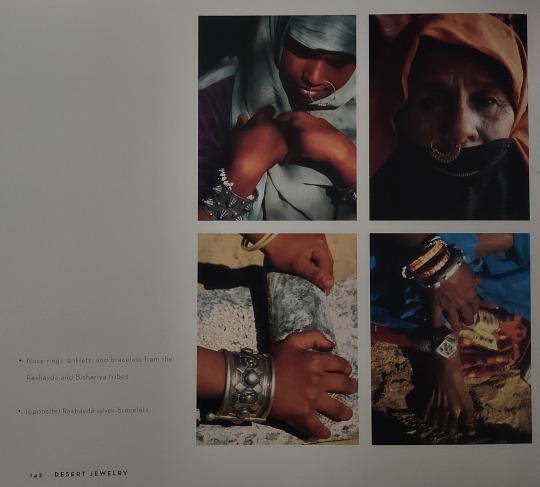
In Sinai, the nose ring is called a shenaf. It has a great deal of similarity to Palestinian nose rings, and has a similar construction to Bahariya nose rings with the lower half full of filigree and granulation. It also sometimes has beads and hanging pieces. It is most commonly made of gold.




Other miscellaneous pictures of Egyptian nose rings:

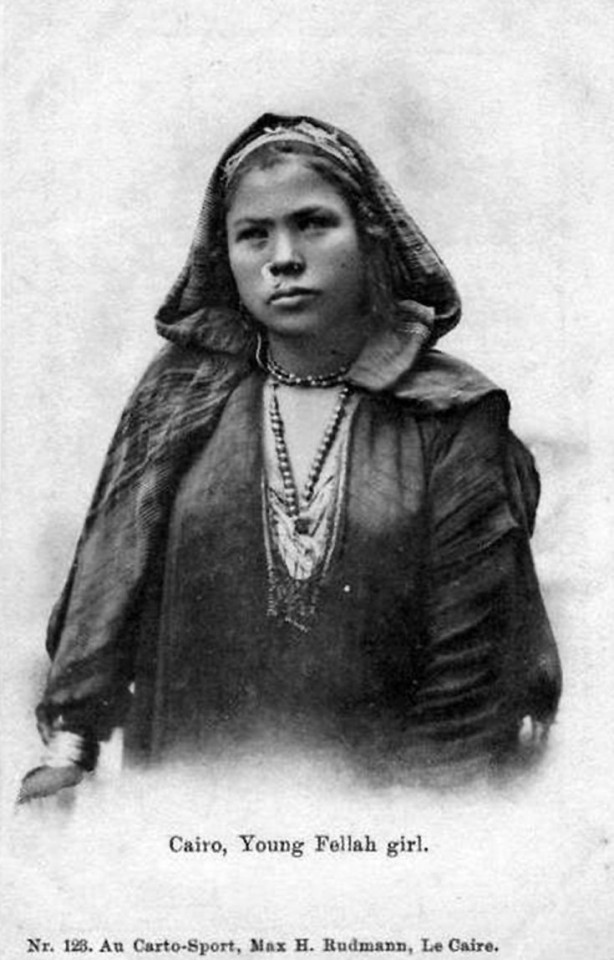


Further reading:
https://newvoices.org/2021/05/14/most-decorated-women/ https://newvoices.org/2021/05/24/i-put-a-ring-in-your-nose/ | Regarding Jewish piercings and body art
https://www.google.com/amp/s/www.dharmadispatch.in/amp/story/history/the-nose-ring-or-nath-is-an-import-from-muslim-invaders https://www.naturaldiamonds.com/style/natural-diamonds-nose-pin-history-legacy/ | regarding Indian nose rings. The first one is unfortunately incredibly biased against Muslims, and I wouldn't link it if I could find a better write up of the argument regarding nose rings being an import to India. I debated including it at all, but figured I should stick to my rule for citing biased sources in Egyptian fashion research; include it, but note the problem.
The Traditional Jewelry of Egypt by Azza Fahmy
The Manners and Customs of the Modern Egyptians by Edward William Lane
https://collections.vam.ac.uk/item/O79718/earring-unknown/
https://collections.vam.ac.uk/item/O79793/earring-unknown/
https://collections.vam.ac.uk/item/O79718/earring-unknown/
http://collections.vam.ac.uk/item/O79342/earring/earring-unknown/
https://collections.vam.ac.uk/item/O79454/earring-unknown/
https://trc-leiden.nl/collection/?trc=&zoek=saudi&cat=Accessories&subcat=&g=&s=24&f=0&id=2435
https://www.philamuseum.org/collection/object/41469
66 notes
·
View notes
Text
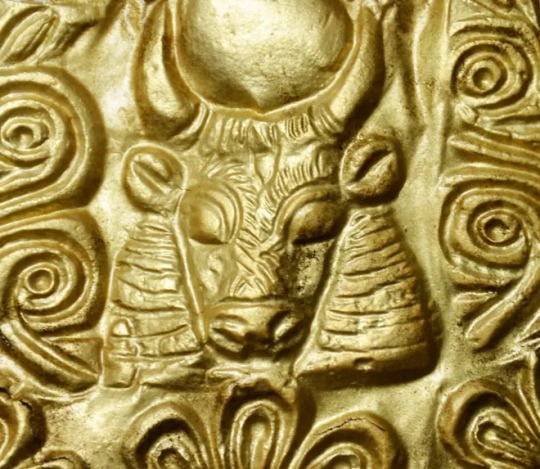
Tombs Rich in Artifacts Discovered in Cyprus
An archaeological expedition from Sweden's University of Gothenburg has uncovered tombs rich in artifacts and antiquities in Cyprus that makes the discovery among the richest ever found in the Mediterranean region.
Peter Fischer, the leader of the expedition and a professor of archaeology at the University of Gothenburg, said “considering the richness of the grave goods, it is a reasonable assumption that these were royal tombs, even though we do not know much about the form of government practiced in the city at the time."
Fischer believes that the artifacts, found just outside the Bronze Age trading city of Hala Sultan Tekke, indicate the tombs' occupants ruled the city, which was a center for copper trade between 1500–1300 BCE. The tombs, located outside the 50-hectare city, consist of underground chambers of varying sizes, accessed via a narrow passage from the surface.
Cyprus' Department of Antiquities, in an update posted to their website, noted: "The city’s wealth seems to have been based on the production of copper and trade with near and distant cultures. Judging by the rich burial gifts, the tombs belonged to families of the city’s ruling class who took part in the export of copper and intercultural trade."
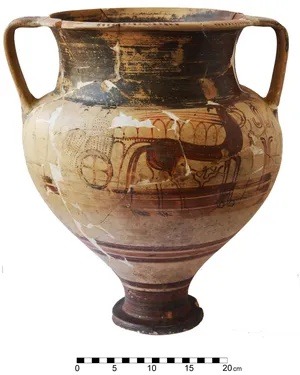
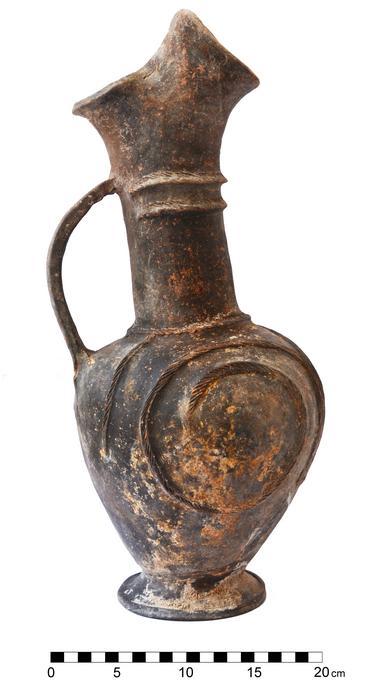
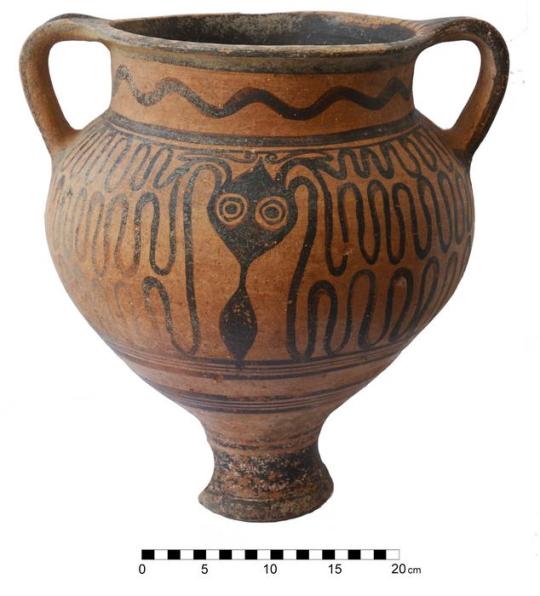
Unearthed artifacts include imports from Egypt, Baltic region
The Swedish Söderberg expedition has been carrying out excavations in Hala Sultan Tekke near the city of Larnaca on the south coast of Cyprus since 2010. Though the expedition has previously found chamber tombs with valuable grave goods, the latest discovery is unprecedented given the superb quality and quantity of artifacts.
“We found more than 500 complete artifacts distributed among two tombs. Many of the artifacts consist of precious metals, gems, ivory and high-quality ceramics," Fischer said.
About half of the artifacts unearthed during the expedition are believed to have been imported from different civilizations. For example, gold and ivory came from Egypt while precious stones, such as blue lapis lazuli, dark red carnelian and blue-green turquoise, were imported from Afghanistan, India and Sinai respectively. Amber objects from the Baltic region were also found among the artifacts.
The Department of Antiquities said that three chamber tombs, preliminarily dated to the 14th century BC, were exposed. While one of them had been looted, most likely in the 19th century AD, the other two were "undisturbed", apart from the collapse of their chambers.
Items recovered from those include locally produced pottery and ornaments and numerous items of jewelry such as diadems, which are ornamental headbands. Embossed images of bulls, gazelles, lions and flowers adorn the diadems. Bronze weapons, some inlaid with ivory, were also recovered as well as a gold-framed seal made of the hard mineral hematite with inscriptions of gods and rulers.
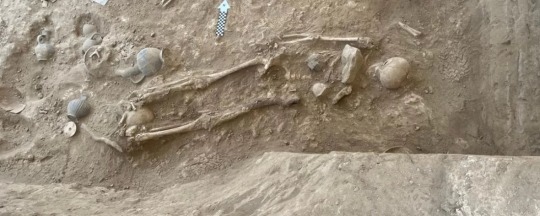
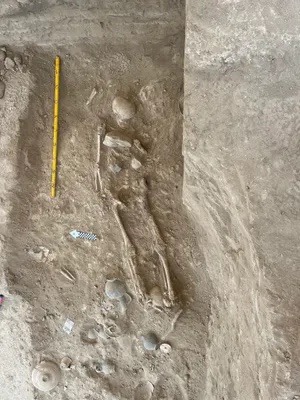
"Several items of ivory and faience are imports from Egypt during the famous 18th Dynasty, the time of the well-known pharaohs Thutmose III, Amenophis IV (Akhenaten) and his wife Nefertiti," said the department.
The excavation team used magnetometers, a type of instrument that can produce images showing objects and structures up to two meters beneath the surface, to carry out their expedition, according to the university.
Besides artifacts, the research team also unearthed several well-preserved skeletons in the tombs including one of a woman surrounded by dozens of ceramic vessels, jewelry and a round bronze mirror. A one-year-old child with a ceramic toy also lay beside her.
By Saman Shafiq.
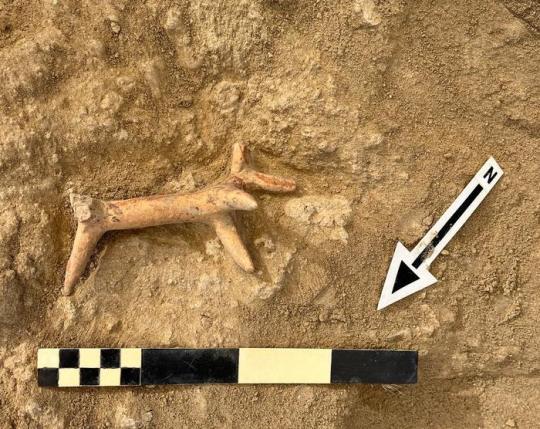
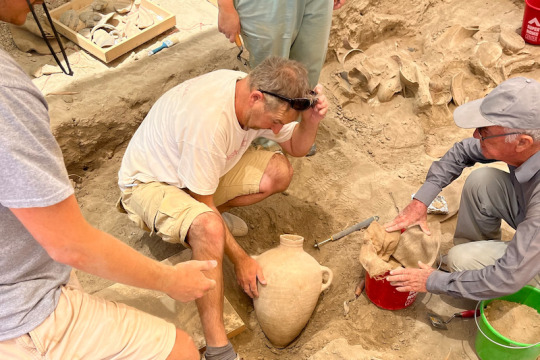
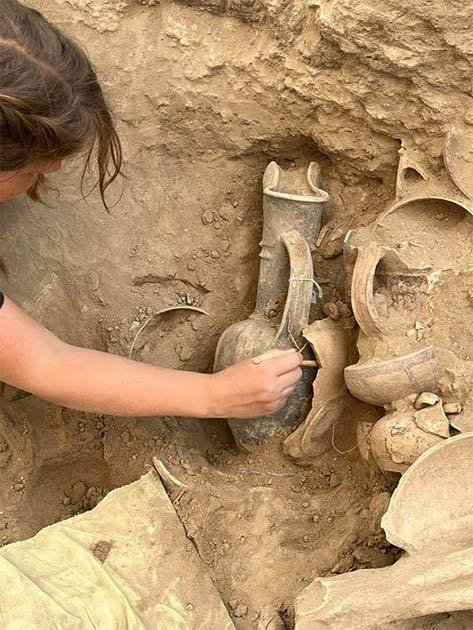
#Tombs Rich in Artifacts Discovered in Cyprus#Bronze Age city of Hala Sultan Tekke#ancient tomb#chamber tombs#ancient graves#ancient artifacts#archeology#archeolgst#history#history news#ancient history#ancient culture#ancient civilizations
40 notes
·
View notes
Text
The world has failed to halt a downward spiral in humanitarian conditions for civilians in the Gaza Strip since the Israel-Hamas war began last October. The airdropping of humanitarian aid and the U.S. plan to construct a temporary port off the coast of northern Gaza to deliver assistance, both in coordination with Israel, will not adequately relieve the crisis or eliminate its root cause. In addition to being financially unfeasible, neither approach can be sustained amid continued armed conflict and Israel’s blocking of aid entering the strip via land borders.
The only feasible and sustainable way to relieve the humanitarian crisis in Gaza is through an emergency mechanism that removes Israel’s total control over the security inspection and entry of aid via land borders into the besieged territory. This proposed plan, limited to the duration of the war and the resulting humanitarian crisis, should include an international security task force with the limited mandate of overseeing and implementing an independent inspection and transport process for aid through Egypt’s Sinai Peninsula.
This emergency mechanism is not far-fetched and could be immediately applied if world powers were willing to utilize all means necessary to rescue Palestinians in Gaza from famine, a devastated health system, and harrowing levels of deprivation. Such an intervention would boost efforts to stop the mounting threat of a regional conflict as well as bring progress toward negotiations to reach a cease-fire. Now is the time to do so.
In the Sinai Peninsula, just across the border from Gaza, tens of thousands of tons of humanitarian aid are waiting for Israel’s permission to enter the strip. Images show hundreds of flatbed trucks loaded with aid and blocked by Israel’s security inspection system at the Kerem Shalom border crossing, including some parked for weeks. In wartime, it is imperative that aid shipments undergo strict security checks, but such a system must not be manipulated by any warring parties for military gain—in this case, either Israel or Hamas.
Instead, a joint task force, comprising security personnel from different governments and an international security body, could oversee the system. Egypt, Qatar, the United States, and France, in partnership with the United Nations, are the top parties—but not the only ones—capable of operating this limited-mandate force. All have consistently engaged both Hamas and Israel, along with local authorities and humanitarian organizations operating in Gaza, on hostages, aid and rescue, policies to protect civilians, and negotiations toward a cease-fire.
Egypt is a fitting and capable host: It not only maintains the sole land border and entry point into Gaza that is not under Israeli military control, the Rafah border crossing, but it also has become the destination of most humanitarian aid dispatched for Gaza. Since the beginning of the war, shipments have continuously landed in El-Arish Airport in North Sinai, some 31 miles from the Rafah crossing—which is just south of the town of Rafah in Gaza, where an estimated 1.5 million people are sheltered.
In the last decade, the Egyptian military and security forces have turned this part of North Sinai into the country’s most militarized zone. It is so secure that it has received heads of government, top U.N. officials, members of parliament, and other officials since the war in Gaza began. At El-Arish, French and Italian navy hospital ships have docked for weeks to provide medical aid to Palestinians, while other vessels have unloaded aid shipments.
Egypt could immediately designate a site to host a security inspection effort and the joint task force needed to implement it. In fact, Cairo has already said it is building a logistics hub to host aid efforts near the Rafah crossing terminal.
Since the war began, senior U.S. officials including Secretary of State Antony Blinken and CIA Director Bill Burns have conducted multiple visits and engaged in talks with regional governments involved with efforts to contain the conflict. After the Hamas attack on Oct. 7, 2023, U.S. President Joe Biden appointed David Satterfield as special envoy for Middle East humanitarian issues. Satterfield is no stranger to the region’s volatile security; he served as director-general of the Multinational Force and Observers in the Sinai Peninsula from 2009 to 2017.
Qatar and France are as active as Egypt and the United States in all levels of engagement with the warring parties. Qatar’s capital, Doha, hosts the Hamas leadership outside of Gaza. Qatari efforts have led to the release of Israeli civilians held hostage by Hamas after the Oct. 7 attack. Qatar and France also secured a deal to allow delivery of lifesaving medicines to Gaza’s hospitals as well as to Hamas-held hostages. Qatar also constructed and operates a field hospital inside the strip and has dispatched aid to North Sinai since the start of the war.
Finally, the United Nations has powerful reach and ability, especially through on-the-ground humanitarian operations in Gaza. Its various bodies, including the Secretariat, the U.N. Relief and Works Agency for Palestinian refugees, and the U.N. Office for the Coordination of Humanitarian Affairs, are in constant communication and coordination with all parties involved. Despite the level of destruction in Gaza, they operate a broad network of employees and facilities dedicated to humanitarian aid.
With a force as small as 100 well-equipped security personnel and a site secured and serviced by Egypt’s military and local authorities at the Sinai-Gaza border, the joint security task force could theoretically inspect up to 50 trucks per hour, delivering the required minimum of 500 trucks per day within 10 hours. Cargo planes could not airdrop a fraction of that aid over Gaza every day for an extended period. And according to the United States, its port plan will take around two months, as many as 1,000 troops, and millions of dollars to provide just 2 million meals per day.
The emergency mechanism’s mandate would stop at the delivery of aid across Egypt’s Rafah terminal into Gaza. It would not encroach on the jurisdiction of local authorities and organizations or replace them. Within this strictly limited mandate, the aid mechanism and its task force wouldn’t pose a threat to any warring parties or provide political or military gain. It would operate impartially for the protection and rescue of civilians, most of whom are women and children.
An alternative mechanism to deliver humanitarian aid would not only save civilian lives, but it would also create a path toward a lasting solution that averts further crisis. Delivering the minimum required aid to Gaza could satisfy the basic needs of the 1.5 million people sheltering in Rafah within days. It would help reinforce Gaza’s devastated health care system and mitigate the risk of infectious diseases and chronic illnesses caused by malnutrition and medical shortages.
With an emergency mechanism in place that guarantees delivery without manipulation, donor countries and organizations would increase their efforts to send humanitarian aid to Gaza to satisfy the unprecedented level of need. Such guarantees could also contain panic across Gaza, creating a safer environment for organizations to transport and distribute aid throughout the strip. A continued flow of aid would gradually end the overwhelming of convoys by desperate civilians and undercut war profiteers and organized gangs seeking to commandeer shipments.
By hosting such an effort, Egypt would avoid its looming nightmare: a sudden influx of refugees crossing its borders in pursuit of safety and sustenance that would possibly deal a blow to the Camp David Accords, which maintains peace between Egypt and Israel. On a domestic level, the joint aid effort would address popular anger with Egyptian President Abdel Fattah al-Sisi for failing to open the Rafah border crossing and unilaterally deliver aid to Gaza—with practical measures rather than ineffective statements and oppression of Egypt’s political opposition.
An alternative aid mechanism would also have far-reaching effects on growing regional conflict in the Middle East. While international powers and mediators are scrambling to contain hostilities between Hezbollah in Lebanon and Israel and the Houthi threat in the Red Sea, a practical approach to enforce a solution to the humanitarian crisis in Gaza could advance potential negotiations. Both Hezbollah and the Houthis have repeatedly pointed to the siege on Gaza’s people in official statements; although both have other calculations behind their attacks against Israel and its interests, containing the humanitarian crisis in Gaza would serve as a step toward reaching a settlement on both fronts.
Israeli Prime Minister Benjamin Netanyahu and his government will most certainly oppose any such efforts. But it is in the immediate power of the international community, and especially the Biden administration, to confront Israel and enforce solutions that will save lives. In this case, any Israeli opposition to the mechanism, whether by attempting to block its inception or by targeting aid after it enters Gaza, would be directed at a consortium of international and regional powers.
It would also contravene the provisional measures laid out by the International Court of Justice: that Israel “take immediate and effective measures to enable the provision of urgently needed basic services and humanitarian assistance to address the adverse conditions of life faced by Palestinians in the Gaza Strip.”
As Israel’s top provider of arms and aid, and in light of the potential threat that Biden’s policies toward the war in Gaza pose to his electoral prospects in November, it is in the administration’s interest to use its leverage to compel Israel not to block such an extraordinary measure. Failing to endorse and partner in such an effort would deepen the growing gap between the United States and the Middle East, leaving a vacuum that will inevitably be filled by other world powers.
Six months into the Israel-Hamas war, it would be naive to assume that any progress could be accomplished without an immediate and collaborative intervention by regional and international powers to remedy the humanitarian crisis in Gaza. Only then will hindered talks toward a cease-fire agreement and a settlement of the war stand a chance.
7 notes
·
View notes
Text
‘A frightening precedent’: New Zealand to send military personnel to target Houthis
By Mick Hall
Jan 25, 2024

Bombing one of the most impoverished nations on Earth over its sea blockade to stop genocide in Gaza reflects Kiwi values, Prime Minister Christopher Luxon says.
A decision to send military personnel to the Red Sea to help bomb Yemen reflects New Zealand’s values and a desire to protect the “rules-based international order”, New Zealand’s Prime Minister Christopher Luxon says.
Addressing his first post-Cabinet media stand-up on January 23, Luxon announced the deployment of six NZDF members to target Houthi assets for UK and US bombing missions. The deployment is to last up to 31 July.
Luxon was accompanied by Foreign Minister Winston Peters and Defence Minister Judith Collins.
The decision was greeted with alarm by a range of politicians and peace campaigners.
In Context revealed in December the government was weighing up a request from the US to send military assets to support Operation Prosperity Guardian, a naval coalition formed to confront Ansarallah/Houthi attacks on commercial shipping in the Red Sea and Gulf of Aden in response to Israel’s military onslaught against Gaza.
Yemen has now been targeted in strikes on eight separate occasions since it was first attacked on January 12, a move New Zealand backed in a joint statement by 10 countries. The US has said the bombing campaign is separate from and not associated with Operation Prosperity Guardian.
In the latest attack on January 22, Yemen’s capital was hit Sanaa as up to 30 strikes on targets across the country aimed at degrading drone and rocket capabilities were recorded.
Luxon said the NZDF personnel would not enter Yemen and would be used in an intelligence gathering capacity, based at an undisclosed location outside of New Zealand.
New Zealand military officers already operate out of a US base in Jordan, working alongside others as part of Operation Gallant Phoenix. The intelligence cell of about 250 personnel was originally set up in 2013 to monitor foreign Islamic State (IS) fighters in Iraq and Syria, but is said to target “terrorist” groups across the region regardless of ideology.
The US Department of State announced on January 17 it was designating the Houthis as a Specially Designated Global Terrorist group.
The Yemeni forces announced in November shipping destined for Israel and vessels linked to the country would be targeted in response to Israel’s Western-backed genocidal onslaught in Gaza, which began after the Hamas attack on October 7.
Houthis ‘destabilising’
The Houthis have targeted other naval and commercial ships, including those owned by US and UK interests. In response, shipping giants have decided to use travel around Africa, through the Cape of Good Hope, rather than attempt to use the Suez Canal, adding up to 10 days to journeys. Approximate 400 commercial vessels use the route at any one time.
Luxon said: “Houthi attacks against commercial and naval shipping are illegal, unacceptable and profoundly destabilising.
“This deployment, as part of an international coalition, is a continuation of New Zealand’s long history of defending freedom of navigation both in the Middle East and closer to home.”
The Israeli bombardment of under-siege Gaza has officially killed nearly 26,000 Palestinians, most of them women and children, with many of the strip’s displaced residents now on the verge of starvation and threatened by disease. A leaked Israeli government document revealed last year Israel would like to expel the 2.3 million population into Egypt’s Sinai desert.
In an often-incoherent appraisal of the New Zealand’s foreign policy settings, Luxon said his government’s decision to help bomb one of the most impoverished nations on Earth at the behest of the US was ethically grounded and necessary to maintain a rules-based international order, a descriptor for US hegemony.
“It’s about values. It’s about standing up for things we believe in and we need to talk about them, but we also need to do something about it as well to make sure that we put real capability alongside our words and that’s what we’re doing,” he said.
As Israel prepared a ground assault in Gaza in late October, US and UK naval and military assets were deployed to the region to deter the so-called Axis of Resistance – Hezbollah in Lebanon, Iran and Yemen’s de facto government – from intervening in Israel’s operation, which was described by South Africa at the International Court of Justice earlier this month as a genocide.
As the Gaza killings continue, Israel’s repeated bombing of neighbouring Lebanon and Syria over the past month, with the killing an Iranian general in Damascus and a senior Hamas figure in Beirut, threatens to create a catastrophic regional conflagration.
Wrong to ‘conflate’ issues – Luxon
Luxon said it was wrong to “conflate the two issues” of Houthi attacks and Israel actions in the Middle East. He claimed that 31 attacks from Yemen that had affected 60 countries were “hugely indiscriminate” and that attacks on shipping would have happened regardless of Israel’s operation in Gaza.
“What is obvious is they’ve tried to run an argument but it’s not held up in fact. It’s been a really indiscriminate attack in commercial shipping,” he said.
The Houthi disruption of shipping had the potential to cause starvation, he added.
Foreign Minister Winston Peters said the attacks on commercial shipping routes had affected hundreds of millions of people. He said the Houthi actions also threatened New Zealand’s national interests as a trading nation and necessitated military action. He said the government would “not be intimidated” by the threat of Houthi attacks on Kiwis.
Defence Minister Judith Collins said the US-led coalition’s response was an inevitable consequence of Houthi actions and were designed to address “a serious threat of global stability”.
Palestinian Solidarity Network Aotearoa (PSNA) spokesman John Minto called the government’s justifications for sending personnel “shamelessly hypocritical” and said it would only add fuel to the fire.
“Luxon should be condemning Israel’s slaughter of Palestinians in Gaza as ‘illegal, unacceptable and profoundly destabilising’ and yet Mr Luxon refuses to utter a single word of criticism on Israel despite the death toll of over 25,000 Palestinians – including over 10,000 children,” he said.
“Foreign Minister Winston Peters saying the deployment should not be linked to recent developments in Israel and the Gaza strip is simply laughable.”
Without Parliamentary mandate – Te Kuaka
New Zealand foreign policy group, Te Kuaka, called the deployment “deeply alarming”. Co-director, Dr Arama Rata, said it would “inflame regional instability and cause more civilian deaths without addressing the root cause of the Houthi actions, which is ending the genocide in Gaza.”
She said the decision was made without a Parliamentary mandate and that there had been no explicit authorisation of military action in self-defence against Yemen by the UN Security Council.”
“This sets a frightening precedent for how foreign policy decisions are made. There are huge risks to not just the Middle East, but New Zealand directly when we take the side of the US and the UK, nations that have a long history of oppressive intervention in the Global South.”
Peters told media the opposition had not been consulted about the decision because the government didn’t think it needed to.
Rata added: “We need to have an honest reflection about our positioning alongside the US and the UK. Instead of colluding with these colonial powers, we should be standing with countries like Brazil and South Africa, which are challenging old colonial regimes, and represent the majority of the international community.”
The Green Party said the government should be focused on de-escalation.
“We are horrified at this Government’s decision to further inflame tensions in the Middle East by sending New Zealand Defence Force personnel to the Red Sea,” co-leaders of the Green Party, Marama Davidson and James Shaw said.
“It seems inconceivable for this government to be so dangerously naïve to say that this deployment has nothing to do with the horrific violence that continues to suffocate Gaza. The Government should be using every opportunity to push for a permanent ceasefire in Gaza.”
As well as failing to call for an immediate ceasefire, the government has failed to support South Africa’s application to The Hague for an interim injunction to stop Israel’s military operation in Gaza while the court makes a determination on whether Israeli is guilty of genocide against Palestinians.
There were also moments during the post-cabinet media event where a duplicity in paying lip service to the notion of Palestinian statehood seemed exposed.
When asked if the government would recognise the state of Palestine a clearly bemused Luxon deferred to Peters, who claimed the government supported a two-state solution to the Palestine-Israel conflict, but would not recognise Palestine as a state as its borders were not defined.
The Oslo peace accords of the 1990s clearly defined the borders of a future Palestinian state.
When pressed over the fact borders were defined, so why not support Palestinian statehood, a befuddled Peters replied: “Because the Prime Minister of Israel made a statement to the contrary… he didn’t support the two-state solution”.
Luxon bizarrely added it was because Palestinians didn’t have a functional government.
Over the weekend, Israel Prime Minister Benjamin Netanyahu rejected the idea of Palestinian statehood as an existential threat to Israel. He posted on social media: “I will not compromise on full Israeli security control over the entire area west of [the river] Jordan — and this is irreconcilable with a Palestinian state”.
So New Zealand's gone full fascist.
#Palestine#Red Sea#Yemen#Houthis#Genocide#Axis of Resistance#Apartheid#israel is an apartheid state#death to israel#fuck israel#israel is committing genocide#israel is a war criminal#israel is a terrorist state
6 notes
·
View notes
Text
IN A MINUTE:

AN INDIE EXPRESS...

“DEMOLITION MAN” is the official lead single from @drugchurch’s forthcoming LP titled ‘Prude’ (10/4 @purenoiserecs) & it finds the veteran Albany-based outfit “envying dogs because they know what they’ve gotta do each day” across a sub-3 min slice of gruffly chugged, radically riffed & righteously raged AltCore.

@sinaivessel are here w/ “CHALLENGER,” a choice cut from their latest LP titled ‘I Sing’ ( @keeledscales) & it finds vocalist/multi-instrumentalist Caleb Cordes’ Asheville-based project maintaining “some sense of health in a world that can constantly feel quite threatening” across 3+ mins of downtrodden IndieRock.

“I’VE BEEN EVIL” is the latest single from @spiritofthebeehive’s forthcoming LP titled ‘You’ll Have To Lose Something’ (8/23 @saddlecreek) & it finds the Philadelphia-based trio of Zack Schwartz, Corey Wichlin & Rivka Ravede holding fast across a steady 2:34 clip of straightforwardly stripped down ArtRock.

@sf59 are back w/ “909,” the lead single from their forthcoming LP titled ‘Lust For Gold’ (8/16 @velvetbluemusic) & it finds the long running California-based quintet of J. Martin (guitars/vox), S. Dail (bass), C. Martin (drums/bgv), R. Withem (guitar) & F. Lenz (percussion) bringing their OG brand of heavily distorted & pedal gazing goods across 4 mins of guitar-driven AltRawk.

“SMILE” is a choice cut from @wandband.info’s latest LP titled ‘Vertigo’ ( @dragcityrecords) & it finds the Los Angeles-based quartet of Cory Hanson, Evan Burrows, Robert Cody & Evan Backer bringing the blown-out crunch across a sprawling 6 ½ mins of tastily licked, tenaciously tempered & fuzzed-out PsychRawk.
2 notes
·
View notes
Text

5 Potential Medical advantages of Gua Sha
This conventional Chinese medication strategy might assist with alleviating torment, help flow, and further develop side effects of certain illnesses. Figure out how.
All that old is turning out to be to some degree new once more. For this situation, we're alluding to gua sha, a conventional Chinese medication strategy accepted to offer numerous medical advantages.
The health practice includes scratching your skin with a coin, spoon, or stone until little red spots (called petechiae) show up. Petechiae show broken vessels under the skin, and they are remembered to make remedial impacts, including advancing bloodstream and dissemination and possibly working on your body's regular mending process.
"Gua sha signifies 'to scratch sand,' and it was generally utilized in China to support the development of 'qi,' or energy stream," says Elizabeth Bahar Houshmand, MD, a board-confirmed dermatologist situated in Dallas and an individual of the American Foundation of Dermatology.
Customary Chinese medication professionals trust that by invigorating petechiae and advancing energy stream, gua sha can mitigate side effects of certain infections and other well-being protests, per Johns Hopkins Medication.
Be that as it may, what does the exploration say? Peruse on to realize what benefits gua sha may offer.
1. May Assist with easing Persistent Torment
As per Houman Danesh, MD, head of integrative agony the executives at the Icahn Institute of Medication at Mount Sinai in New York City, gua sha elevates blood stream to the area being scratched, which can assist with diminishing agony and solidness. "It's normally used to get alleviation from strain migraines, neck and back agony, or expanding," he says.
As a matter of fact, numerous actual specialists utilize the Graston Strategy, a technique like gua sha, to lessen torment and further develop versatility in individuals with outer muscle conditions.
"Thus, in the event that somebody has glue capsulitis, otherwise called frozen shoulder, you could do gua sha on the shoulder to separate minute scar tissue or grips," says Jeff Gould, an authorized needle therapy specialist with the Johns Hopkins Integrative Medication and Stomach related Center in Lutherville, Maryland. Scratching assembles the tissue, supports flow, and smooths out muscle hitches, further developing a scope of movement and agony, he makes sense of.
For instance, in a past report, grown-ups with constant neck torment who got a solitary gua sha treatment saw critical upgrades in torment seriousness following multi-week, contrasted and the people who utilized a warming cushion. Whether gua sha is successful for long haul neck torment the board should be concentrated further, in any case.
Likewise, a randomized clinical preliminary distributed in 2019 in Correlative Treatments in Clinical Practice found that patients with ongoing lower back torment detailed less torment power and better general well-being after two gua sha medicines, contrasted and the benchmark group. In any case, more examination is expected to affirm these outcomes.
2. May Assist with facilitating Perimenopause Side effects
Perimenopause alludes to the progress to menopause, or when ladies arrive at the finish of their conceptive years, as indicated by the Mayo Facility. It frequently has actual side effects, making numerous ladies experience hot glimmers, rest issues, and mindset changes.
While there is a wide range of medicines accessible for menopausal side effects, a few ladies go to correlative treatments like gua sha, under the direction of a medical services supplier, to construct an integrative way to deal with managing the perimenopause change.
In a concentrate in China, distributed in 2017 on Menopause, ladies with perimenopause side effects who got 15-minute gua sha medicines one time each week, notwithstanding their ordinary treatment, saw more critical enhancements in side effects and personal satisfaction than ladies who didn't. In particular, the ladies in the gua sha bunch said that they encountered more noteworthy decreases in hot blazes, sleep deprivation, weakness, anxiety, and migraine following two months.
More exploration is required, however, primer proof recommends gua sha may act as a promising, viable, nondrug treatment for perimenopausal conditions in certain ladies.
3. May Assist with working on Diabetic Neuropathy
Diabetic neuropathy is a serious diabetes complexity that might influence up to 50 percent of individuals with diabetes, as per the Mayo Center. It's a sort of nerve harm that happens when elevated degrees of glucose (glucose) harm nerves all through the body.
Diabetic neuropathy is ordinarily found in the legs and feet, causing deadness and agony, and it might bring on some issues in the stomach-related framework, urinary lot, veins, and heart, the Mayo Facility notes.
Gua sha may help by supporting dissemination and improving nerve correspondence. In a randomized controlled preliminary in China, distributed in 2019 in Correlative Treatments in Clinical Practice, patients with diabetic neuropathy saw huge side effect enhancements after 12 week-by-week gua sha meetings, contrasted and the people who didn't get gua sha.
In particular, the patients said that they encountered upgrades in tangible capability, balance, evening consuming sensations in the legs and feet, and plasma glucose levels (a typical technique for diagnosing and observing diabetes).
Considering that examination is extremely restricted, it's probably best that you stay with your ordinary diabetes and nervous system science care as of now, and counsel your doctor before attempting gua sha as a correlative treatment.
4. May Lift Exercise Execution and Recuperation
There is some proof out of China that recommends that gua sha may further develop practice execution and accelerate recuperation a while later.
In a review distributed in 2019 in the Diary of Conventional Chinese Medication, specialists had 44 men get gua sha, farce gua sha (no petechiae), or no gua sha, close by their typical two times week after week weightlifting preparation.
Following two months of treatment, the ones who got gua sha detailed less seen exertion in finishing the grab and quick lift workout, contrasted and different men, despite the fact that everybody utilized just 85% of their one-rep max (the greatest measure of weight they're ready to lift in a solitary redundancy).
Scientists hypothesized that gua sha may have advanced quicker muscle recuperation, as the men weren't restricted by exhaustion from past instructional meetings.
These outcomes reverberate discoveries from a review distributed in 2017 in the Diary of Conventional Chinese Medication. Notwithstanding, bigger investigations are expected to affirm these outcomes.
5. May Alleviate Immune system Sicknesses
While the exploration is restricted, gua sha may help individuals with immune system sicknesses. "You can utilize gua sha to decrease fundamental irritation, so I use it a ton on patients with immune system sicknesses, similar to lupus," Gould says, portraying his own narrative reports of really focusing on his patients. It might assist with bringing down irritation and give side effect alleviation when done on a continuous premise, he says.
Scratching the tissues advances better dissemination of blood and supplements in the body, which can assist with bringing down aggravation. Animating petechiae is likewise remembered to enact mitigating resistant proteins known as cytokines, per a survey distributed in 2021 in the Diary of Family Medication and Essential Consideration.
Remember that gua sha isn't a solution for immune system sicknesses, and that you ought to continuously talk with your essential medical care supplier first prior to attempting any new reciprocal treatments. More examination is as yet expected to comprehend how gua sha may assist individuals with immune system illnesses.
2 notes
·
View notes
Note
You didn't answer the question - where are they supposed to go?
Also - I love how you ignore everything between 1967-2008, (and during 1967 itself)
Such as:
The war in 1967 - that came after tense in the Egyptian-Israeli border:
In the months prior to the outbreak of the Six-Day War in June 1967, tensions again became dangerously heightened: Israel reiterated its post-1956 position that another Egyptian closure of the Straits of Tiran to Israeli shipping would be a definite casus belli. In May 1967, Egyptian president Gamal Abdel Nasser announced that the Straits of Tiran would again be closed to Israeli vessels. He subsequently mobilized the Egyptian military into defensive lines along the border with Israel and ordered the immediate withdrawal of all UNEF personnel.
After Israel's strike on Egypt's airport and (south), Israel was attacked by Syria (north) and Jordan (west). Jordan signed a military contract with Egypt at May 30th, and let Iraqis soldiers into it's border, which was one of the causes for the date - Israel stroke Egypt at June 5th.
This was Israel post-1967:

As you can see, Sinai (pale blue, 300 km) is about the same size as Israel.
But it wasn't in your 2008 map - why?
Well, after 1973 (when, y'know, 4 countries invaded Israel), there was Israel -Egypt peace agreement. Part of it was giving me Egypt the land in Sinai.
(which, by the way, included deporting hundreds of Israeli citizens.)
That peace remained, ever since (give or take incidents such as an Egyptian police officer shoot dead two Israeli tourists and Egyptian guide )
In 2005, Israel's government deported all Israeli villages from Gaza Strip, many of them by force.
Palestinians were given control of the area, in hope for peace. In 2006, Hamas won the first (and only) elections in Gaza.
(The amount of rockets fired from Gaza towards civil areas only kept growing, as well as terror attacks in Israel, including suicide bombing attacks.)
gen question, what are israelis supposed to do? where are they supposed to go?
This can’t possibly be an honest question…


4K notes
·
View notes
Text
Sharm El Sheikh tours
Sharm El Sheikh tours provide the opportunity to explore the beautiful beaches, luxury resorts, and ancient ruins. The city is also home to a variety of wildlife, including dolphins, sharks, and sea turtles. Sharm El Sheikh is an ideal destination for travelers looking for a relaxing and fun-filled vacation.
Cairo Tours From Sharm El Sheikh By Plane This is a great option for travelers looking to explore Egypt from Sharm El Sheikh as it allows them to get around quickly and cheaply.
Glass Boat Trips from Sharm el Sheikh offer stunning views of the Red Sea and the Gulf of Aqaba. Visitors can explore the underwater world with snorkeling and scuba diving. The boats are equipped with all the amenities to ensure a comfortable and enjoyable journey.
We provide the best deals and offers on Luxor Trips From Sharm El Sheikh . . Our friendly team will help you plan the perfect trip. Contact us today to book your Luxor trip from Sharm El Sheikh.
Mount Sinai and St. Catherine Tours From Sharm provide a great opportunity to explore the beautiful and ancient sites of Mount Sinai and St. Catherine's Monastery, two of the most important religious landmarks in Egypt. The tours include round-trip transportation from Sharm and a guided tour of the sites, providing an immersive experience.
Petra Tour from Sharm by Cruise provides unique tours of the area. The tour is conducted by an experienced guide who provides insight into the history and culture of the region. The tour includes stops at the highlights of Petra, including the Monastery and other iconic sites.
Ras Mohammed Snorkeling Tours from Sharm El sheikh The tour includes snorkeling in the Red Sea, with stops at Ras Mohammed National Park and Paradise Island. The tour also includes lunch and snorkeling equipment.
Semi submarine seascope In sharm El Sheikh It is a unique underwater sightseeing experience. Visitors are taken in a semi submarine vessel, where they can view the beauty of the Red Sea. The vessel is equipped with underwater windows and a lighting system that provides a unique experience.
Sharm El Sheikh To Jerusalem & Dead Sea Tour The Tour includes a visit to the beautiful city of Jerusalem and the Dead Sea. The tour also includes a guided tour of the Old City of Jerusalem and a visit to the Mount of Olives. The tour concludes with a visit to the Dead Sea.
St Catherine and Colored Canyon Tours provide a unique and exciting way to explore these natural wonders. The tours are guided and provide an opportunity for visitors to learn about the geology, history, and culture of the area.
Enjoy a day exploring Tiran Island and its beautiful coral reefs via Tiran Island Snorkeling Trip Swim and snorkel with colorful fish and turtles in the crystal clear waters. Relax and sunbathe on the white sand beaches.
One of our Sharm El Sheikh Tours
If you are Interested In Marine adventures, Explore our Tiran Island Snorkeling Trip, and Experience A Day of Luxury and Fun, on Tiran island Get delighted with the Interesting and Exciting water Activities, try sail boating swimming, diving, snorkeling into the white crystal water of the Sinai.
Jana Tours Delegate will pick you up from your hotel in Sharm El Sheikh To start Tiran Island Snorkeling Trip. This snorkeling destination is home to vibrant coral reefs. On this excursion, you will see a variety of marine creatures. You do not need to have any prior snorkeling experience to visit this unique place. Each snorkel tour begins with a briefing conducted by the crew who will make sure everyone has his/her proper snorkel equipment and provide with snorkeling tips such as clearing your mask, swimming with your fins, Lunch will be served during your tour to Tiran Island, at the end of your tour, you will be transferred to your boat, Return To Your Hotel In Sharm el sheikh.
The suggested half-day tour will include the following:
§ Pick up services from your Hotel in Sharm El Sheikh.
§ Transportation with A/C van to all the mentioned sites.
§ Entrance fees for all the mentioned sites.
§ Mineral water.
§ Service charge and tax.
The 1 day tours will not include the following:
§ Visa for entry to Egypt.
§ Optional tours.
§ Any other items not mentioned.
§ Tipping kitty.
· Sharm El sheikh Tours: https://bit.ly/3AwoiJT
· · · Website: https://jana.tours/
· · · Whatsapp+201143320224
· · · Email :[email protected]
0 notes
Text
Sinai Vessel Break Up
Sinai Vessel are calling it a day. 15 years is a longer span of time than I know how to talk about. It contains the whole of my adult life and nearly half of my life besides. Good grief. My time outside and within Sinai Vessel can be parsed, but they’re two strands in a cord. And the Sinai Vessel strand is a series of events that is always connected to — if not directly responsible for — every relationship and memory I hold dear. To say I’m thankful for it is to say I’m thankful to have lived at all. And I am thankful. But it has not been easy. Somewhere along the way, Sinai Vessel became a means for me to dress for the job I wanted. I never got that job. I saw friends and peers get the call. I put my nose to the grindstone. I worked my ass off, I enjoyed some true victories. And I spent a long time questioning what was wrong with me or the things I made. My math was wrong, I know. As a loved one put it, it’s insane to be frustrated with myself for not winning the lottery. But still I was, I am. And I’ve tried for a long time to untangle making music from the sick cycle of hope, but I can’t. At least not under this name or banner. It’s too storied, too complicated, it’s gone on too long. There are so many selves that have been involved in this thing. I’ve spent years dreaming of the accidental fire that would reduce it all to zero, but that too is a lottery fantasy. Sometimes you’ve gotta burn it down yourself. If I only once had a hundred people listen to me sing in a given room, only once had as many bend their ear towards something I’d made, I’d be in a privileged quotient of humanity that’s smaller than I could comprehend. I’ve had that many times over. I got to make things I’m proud of with people I adore. And I have felt seen far more often than any one person deserves. Moreover, I learned how to see myself. Goodnight, Sinai Vessel. It’s time to step beyond your fences. I hope that in relieving myself of this pursuit I can be a kinder friend, a better collaborator, a gentler companion to both myself and others. You have taught me everything and I’m taking it all with me. Thank y’all for listening — then, now, whenever you hear from me down the road. It counts now more than it ever has. --- Please consider becoming a member so we can keep bringing you stories like this one. ◎ https://chorus.fm/news/sinai-vessel-break-up/
0 notes
Text
01 - Swirls - We March 02 - Gut Health - Two Steps 03 - Rat Boy - DAY TRIP TO LONDON 04 - cumgirl8 - mercy 05 - La Femme - Sweet Babe 06 - Cyril Cyril - Chat Gepetto 07 - Redd Kross - Terrible Band 08 - Laughing - Bruised 09 - Teenage Tom Petties - Dumb Enough 10 - Diary - I Wanna Watch the Game 11 - CŒUR A L'INDEX - Parler de Toi 12 - Wut - Guts, Brains 13 - Young Scum - Away 14 - Mood Six - Flowers And Boxes 15 - Guy Blackman - Stay On the Beat 16 - Slacks - Donny 17 - Kit Sebastian - Göç / Me 18 - Pearl & The Oysters - Cruise Control 19 - Suzan Köcher's Suprafon - Falling For Autumn 20 - Celestial Guard - Pied Piper 21 - Phantom Handshakes - Quiet Quit 22 - Lunar Isles - Fade Out 23 - Sinai Vessel - How 24 - Ariella - Ready 25 - Katy Kirby - Naperville 26 - Tasha - Good Song 27 - Cindy - All Weekend
0 notes
